Pale swallow-wort, Rob Routledge, Sault College, Bugwood.org
In any battle, it is important to know your enemy; and the fight against invasive species in Pennsylvania is no different.
Invasive plants are those not native to the commonwealth, grow aggressively, spread quickly, and displace native vegetation.
Because they reduce habitat for native wildlife (and their ability to spread quickly), they often outcompete native plants and “take over” habitats. This limits habitat available for native wildlife and disrupts the food chain.
Many invasive plants came to the commonwealth for use in gardens or landscaping, while others were brought here by accident.
It’s easier and cheaper to control invasive plants when only a few individuals or populations need to be treated. Being aware of potential invaders and being prepared with early detection and rapid response is critical for limiting their negative impacts.
Emerging Invasive Plant Concerns
Pennsylvania has learned to be on the lookout for invasive plant species that are up-and-coming threats.
The following plants have been identified as emerging invasive concerns to the commonwealth, and have recently been voted onto the PA Noxious Weed list.
These plants species were ranked for their “invasiveness” using information available from invasive species databases, scientific literature, expert opinion, and observation by the Pennsylvania Natural Heritage Program through a Wild Resource Conservation Program-funded project.
Japanese Angelica Tree
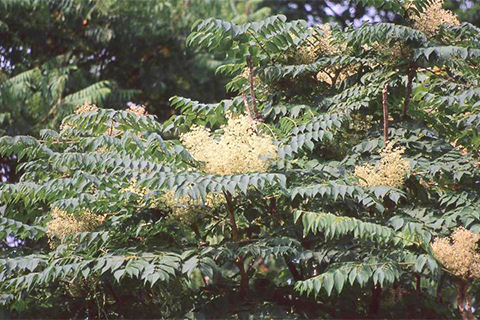
Japanese angelica tree, T. Davis Sydnor, The Ohio State University, Bugwood.org
Japanese angelica tree (Aralia elata) is a relatively new invasive that is increasingly being found in the natural environment. Due to its striking similarity to our native devil’s walking stick shrub, it may often be overlooked.
The structure of the flowering stalk is the most obvious distinguishing characteristic between the two. On Japanese angelica tree, the flower is shorter, with many stems fountaining out from a single point.
Although they look very similar, Japanese angelica tree acts far more aggressively than the native version, replacing other native vegetation and reducing biodiversity. It will grow a dense infestation, spreading by the roots in its own shade.
And of course, this dense growth is covered by heavy spines, making it difficult to travel through!
Japanese Hops
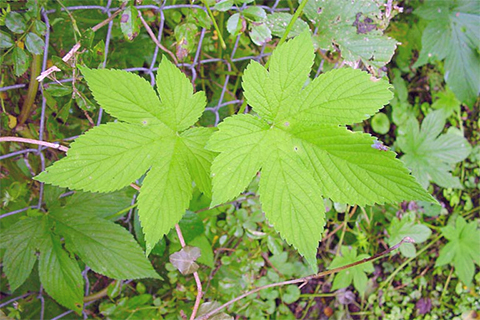
Chris Evans, University of Illinois, Bugwood.org
Japanese hops (Humulus japonica) is a vine native to Asia, which was brought to the U.S. in the mid-to-late 1800s as an ornamental and as a medicinal plant.
It grows as an annual, climbing or trailing vine covered in small prickles that can reach up to 35 feet in length in one growing season.
Its leaves are opposite along the vine and have an average of five lobes with toothed margins and a rough surface.
Despite its name, this is not the kind of hops that are used in making beer -- that’s common hop.
Common hop leaves have either no lobes or three lobes, as opposed to Japanese hops’ five or more lobes.
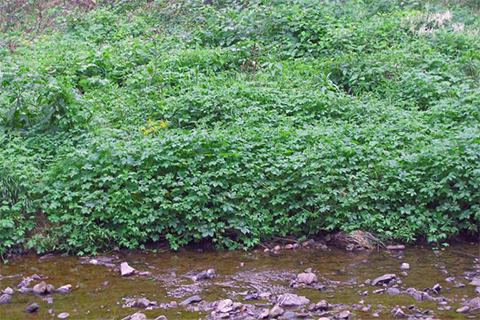
Leslie J. Mehrhoff, University of Connecticut, Bugwood.org
Disturbed habitats like scoured riverbanks, roadsides, and rights-of-way are prime habitat -- although forest edges and fields aren’t off limits either.
In these habitats, Japanese hops can form dense patches that outcompete and smother native vegetation.
This vine spreads through abundant small seeds that can be spread by rivers and streams; and deposited in seed banks that can last three years.
Pale and Black Swallow-worts
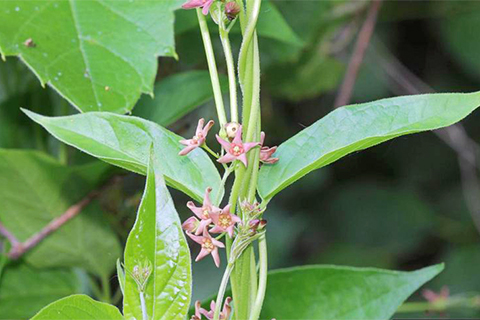
Pale swallow-wort, Rob Routledge, Sault College, Bugwood.org
Pale and black swallow-wort (Vincetoxicum nigrum and V. rossicum) are perennial, twining vines, three to six feet high, which die back to the roots each winter.
Pale swallow-wort has light, reddish colored petals, while black swallow-wort has darker purple flowers.
Their fruit are slender pods which, when fully ripe, release flattened seeds equipped with a downy parachute that aids in wind dispersal.
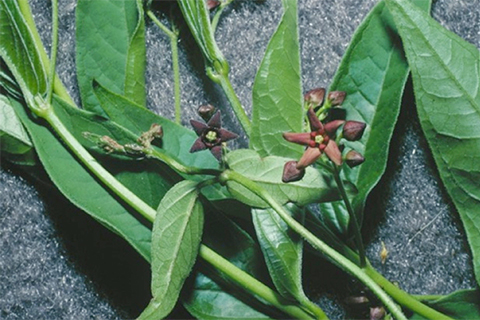
Black swallow-wort, Leslie J. Mehrhoff, University of Connecticut, Bugwood.org
Being closely related to our native milkweeds, swallow-worts are extremely toxic to livestock and monarch butterfly larvae, which some studies show can be fooled into laying their eggs on this plant.
Controlling invasive swallow-worts is an important part of our work to help protect our native monarch butterflies.
There are many native species of Cynanchum -- including honeyvine -- and could be confused with pale swallow-wort.
Native honeyvine has white flowers and its leaves have a distinct heart-shaped base.
How You Can Help Stop the Spread
The best way to help fight against these invasive plants is knowing what they look like! If you see one of these species -- report them at the Pennsylvania iMapInvasives website.
Combating invasive plants can be a daunting task, but by everyone taking some steps at home and in the wild, we can work together to limit their spread.
Learn more about these and other emerging invasive plants at the PA iMapInvasives website.
Learn more about invasive plants in Pennsylvania and how you can help control their spread at DCNR’s website.